Every country has its traditions, and Christmas in Norway is guaranteed to be different to what you might be used to.
Having grown up with many of the same Norwegian Christmas traditions, the locals tend not to think much about them or how much sense they do or do not make.
However, if you’ve grown up elsewhere, many things will seem a little out of the ordinary. You may want to adopt some of them into your own traditions, others you may learn about from the sidelines instead.
Tre nøtter til Askepott
Everyone has the films and TV shows they watch to get into the Christmas spirit or something they’ll watch on the day. For UK readers, this might be Bond or Wallace and Gromit (hopefully not Mrs Browns Boys).
Our American audience might prefer a classic like Miracle on 34th Street or something modern like The Grinch or Home Alone.
Norwegians choose to watch a Czech retelling of Cinderella from the 1970s. As if that wasn’t strange enough, the dubbing is done by one male performer.
The dubbing performer, Knut Risan, could even be considered the voice of Christmas in Norway, as more than 1 million people typically tune in to watch the Christmas classic.
The interesting spin on this version of Cinderella sees her given three nuts that contain a special outfit.
The movie has received the Hollywood treatment in recent years, with a modern remake featuring Norwegian actors. But for many, nothing comes close to the original.
Soda wars
There could be a separate list on the food traditions. For starters, there are the annual light-hearted debates among friends, families and colleagues over which Christmas soda is best.
Many pick one colour, red or brown, and stick to it for the rest of their lives. Other parts of the country may see other colour variations, and in Telemark, there’s a choice between “clear” and “murky”.
Red Christmas soda is usually sweet and fruity, while the brown variant is often more full-bodied and very sweet.
The partisan approach to food doesn’t just end at soda; there are also three Christmas dinner options.
These are cured mutton ribs (pinnekjøtt), ribbe (roasted pork belly), and lutefisk. Lutefisk is a fish that has been cured in lye.
For those unaware of what lye is, the Oxford English Dictionary defines the substance as “a strongly alkaline solution, especially of potassium hydroxide, used for washing or cleansing”.
This gives the fish a gelatinous texture. This and the smell put many off trying the dish.
Do play with your food
Once the annual arguments over food are settled, it is typically time to sit down for your Christmas meal.
Good manners dictate that playing with one’s food is impolite. In Norway, you are specifically encouraged to play with your food when eating a rice porridge/pudding.
This is because there will be an almond in there somewhere. The person who finds the almond wins a marzipan pig.
You are also supposed to leave some porridge out for the nisse. These are gnome-like guardian spirits who live in barns. If you don’t leave the porridge out, the nisse will wreak havoc in the coming year.
Advent calendars
Many grow up with the tradition of Advent calendars. Norwegian do too, they typically have one of the more traditional type and one that takes the form of a TV show.
The majority in Norway grew up watching serialised episodes of Advent calendars. The episodes are released daily and are normally around 20 minutes long.
They normally carry an overall message about what Christmas means in the modern age or the importance of family and friendship.
Julebord
Meaning Christmas table, a julebord is the traditional Christmas party. These can be put on by both your work and any clubs and societies you are signed up for.
Typically, they involve an equal amount of alcohol and speeches. Given how reserved Norwegians can come across, it may be the only time of the year you really see your colleagues let loose.
Such is the popularity of julebord, the weeks leading up to Christmas could be considered a fifth season of the year – julebord season.
While a Christmas party might not sound too strange, it needs to be experienced to be appreciated.



 Please whitelist us to continue reading.
Please whitelist us to continue reading.
Member comments